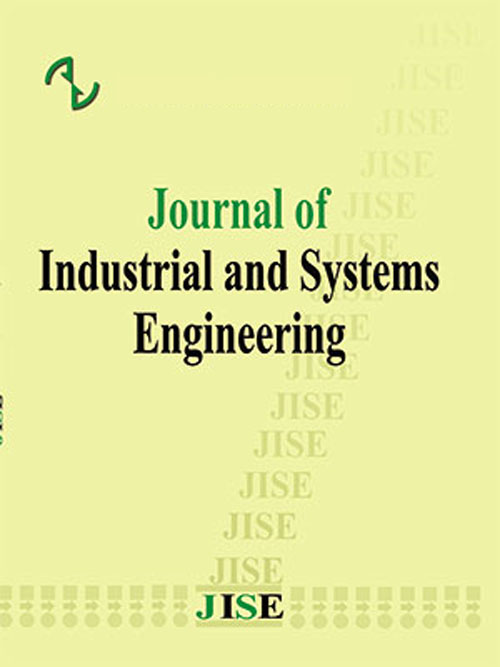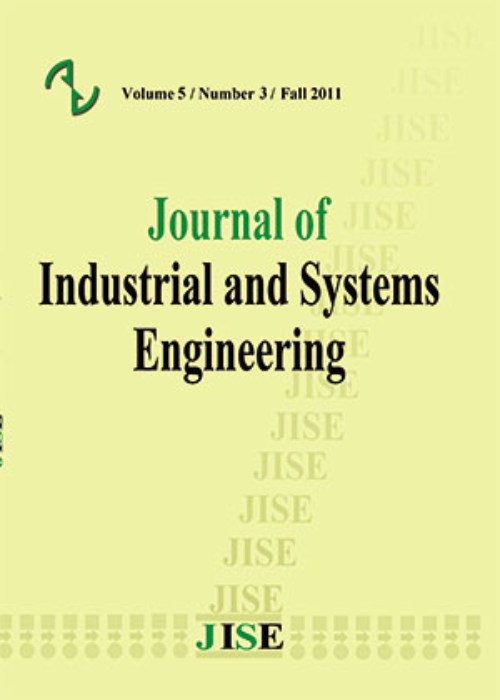فهرست مطالب

Journal of Industrial and Systems Engineering
Volume:9 Issue: 4, Autumn 2016
- تاریخ انتشار: 1395/05/15
- تعداد عناوین: 7
-
-
Page 1The main aim of this paper is to select the best portfolio of renewable energy technologies (RETs) for electrifying an elected area which is not connected to any other grids. Minimizing total costs of the system is considered as the main factor in finding the best decision. In order to make the optimum plan more applicable, the technique of life cycle analysis is applied. This technique takes into account all costs of the system from the manufacturing stage of the different parts of a power plant until their disposal. Also, demand-side management alternatives are considered as competing solutions against the mentioned supply side options. To tackle the problem, an integrated and complex mathematical formulation is developed for finding the optimum energy plan regarding the real world assumptions. For the reason of NP-hard nature of the proposed model and it is hard-to-solve for real large sized problems, a genetic algorithm (GA) approach is additionally developed for solving the mixed integer non-linear model for the medium and large size problems. To evaluate the performance of the proposed GA, a range of random test problems are conducted. The obtained results show that the length of planning period is the core factor in selecting the appropriate portfolio of RETs. Furthermore, it is shown that the proposed GA is capable of producing good results in almost negligible processing times.Keywords: Life Cycle Assessment, Demand Side Management, Genetic Algorithm, energy consumption
-
Page 9During the last years, increased competition among banks has caused many developments in banking experiences and technology, while leading to even more churning customers due to their desire of having the best services. Therefore, it is an extremely significant issue for the banks to identify churning customers and attract them to the banking system again. In order to tackle this issue, this paper proposes a novel personalized collaborating filtering recommendation approach joint with the user clustering technology. In the proposed approach, first the loyal customers are clustered by means of hybrid algorithm based on Particle Swarm Optimization (PSO) and K-means. The clusters of loyal customers are then used to identify the features of the churning customers. Finally, the list of appropriate banking services are recommended for the churning customers based on a collaborative filtering recommendation system. The recommendation system uses the information of loyal customers to offer appropriate services for the churning customers. The proposed intelligent approach was successfully applied to return the churning customers of an Iranian bank.Keywords: Customer churn, data clustering, recommender system, collaborative filtering, particle swarm optimization
-
Page 26This paper studies the multi-factory production (MFP) network scheduling problem where a number of different individual factories join together to form a MFP network, in which these factories can operate more economically than operating individually. However, in such network which known as virtual production network with self-interested factories with transportation times, each individual factory usually focuses on self-benefits and does not care much about the others within the network. We first described the realistic features which incorporate in problem definition. Then two different variants of the problem are considered. In the first case, we propose approximation algorithms with the best achievable theoretical guarantee in three cases: (i) all factories are interested in the makespan, (ii) all factories are interested in the sum of completion times, and (iii) the case in which among allfactories, some factories are interested in the sum of completion times and the others are interested in the makespan. Furthermore, with considering the transpiration, we model the problem as a mixed integer linear programming to minimize the makespan and total completion time and solve it by CPLEX solver to obtain Pareto solutions by applying modified ϵ -constraint approach. Experiments show that this procedure is capable of producing good results to approximate the efficient set.Keywords: Distributed scheduling, Approximation algorithms, ϵ, constraint approach, Pareto solutions, Virtual corporation
-
Page 47The transportation of hazardous materials such as gasoline has unique features due to the nature of these type of materials and the importance role of these material in human life. Therefore, determining the routing of these materials is more challengeable than non-hazardous one due to more dangerous and risky condition besides the transportation costs. Since the distribution of gasoline take places in boarding (24 hours), logistics system should be able to meet these requirements in all of days. In this paper, a new model is developed for planning the route of vehicles as 7×24 (boarding) in order to minimizing the risk of hazardous materials. The proposed vehicle routing model in this paper has been attempted to consider minimization of transportation costs, reduce emissions due to gasoline distribution, consumption, diminishing the routes risk and suggesting suitable time for servicing customers. The proposed model turns in to a single objective model using compromise programming and then solved by GAMS software using the data of case study and then its results have been reported.Keywords: Hazardous, Risk, 7×24 logistics system, Compromise programming
-
Page 65Choosing the proper supplier has a critical role in design of supply chain. This problem is complicated because each supplier may fulfills some of the manufacturer criteria and choosing the best supplier is a Multiple-Criteria Decision Making problem. This paper proposes a novel hybrid approach to rank suppliers in advertising industry and considers two new criteria to evaluate the suppliers in the industry. The proposed approach combines Modified Digital Logic (MDL) and Technique for Order of Preference by Similarity to Ideal Solution (TOPSIS) using fuzzy theory. At the end, the results of the proposed approach is compared with a hybrid method using Fuzzy Analytical Hierarchy Process (FAHP) and Fuzzy TOPSIS on a real case study.Keywords: Fuzzy Theory, Multiple, Criteria Decision, Making, MCDM, MDL, Topsis
-
Page 80The use of GARCH models to characterize crude oil price volatility is widely observed in the empirical literature. In this paper the efficiency of six univariate GARCH models and two methods of estimation the parameters for forecasting oil price volatility are examined and the best method for forecasting crude oil price volatility of Brent market is determined. All the examined models in this paperbelong to the univariate time series family. This article investigates and compares the efficiency of volatility models for crude oil markets. The four years out-of-sample volatility forecasts of the GARCH models are evaluated using the superior predictive ability test with more loss function. The results find that GARCH (1,1) model can outperform all of the other models for the crude oil price of Brent market across different loss functions. Four different measures are used to evaluate the forecasting accuracy of the models. Then, two methods of estimation the parameters of GARCH models, for forecasting oil price volatility are compared. The results suggest that, maximum likelihood estimation (MLE) gives better results for estimation than generalized method of moments (GMM) in this study.Keywords: GARCH (p, q), volatility, Efficiency, crude oil price
-
Page 93This study extends a mathematical model that integrates the location, allocation, inventory replenishment and routing decisions simultaneously. To cope with inherent uncertainty of parameters, we implement a continuous-time Markov process and derive the performance measures of the system. Using the obtained results, the problem is formulated as a mixed integer nonlinear programing model (MINLP), where the total costs of location, transportation and inventory are minimized. In addition,we develop a simulated annealing(SA)-based meta-heuristic algorithm to tackle the computational complexity of the problem. Finally, severalcomputational experimentsare provided to assess effectiveness of the proposed algorithm and the model.Keywords: Markov chain, Location, Allocation, routing, simulated annealing, Inventory


